
Overview
Founded nearly 15 years ago in 2010, Sprout Social has grown to something much bigger than what its name would imply. It’s hardly a sprout at this point, but it also never stops growing. In 2023, the social media management platform averaged an update every 1.2 days, a culture of change that’s been there from the beginning. Look at this article published in late 2011, on the topic of Sprout’s major overhaul of its code base and interface less than two years after launch. The article quotes founder Justyn Howard explaining why this is: “We’re perfectionists with big ambitions.”
Now it’s 2024, and it’s safe to say that those ambitions have been realized. With Howard recently transitioning full time to Executive Chair of the company, Sprout’s current President Ryan Barretto will become its CEO. And, like every change before it at the company, there’s a plan for the future that continues its growth trajectory.
For Sprout’s customers, all they really care about is whether the platform they’ve come to rely on to manage their social media marketing will continue to deliver. And there’s no doubt these customers are happy: Sprout was named the #1 Best Software Product by G2—across all categories. It’s hard to get a few thousand people to agree on anything on the internet, but more than 3000 of them agree that Sprout Social is their most valued tool. Sprout launched with the promise of brands being able to manage multiple social accounts from a single interface. Since then, the platform has added more and more features, with social listening, analytics, and employee advocacy. Sprout’s recent acquisition of Tagger Media’s influencer marketing platform gives them another tool to offer their customers in addition to what they’ve already created. As we start to see more and more marketing platforms start to unify into single solutions—or, at least, suites of solutions—Sprout will no doubt be looking to add to its current roster of 30k+ customers in more than 100 countries. The way things look for them now, both behind and in front of the screen, that should be no problem at all for them.
Pricing
If you saw Sprout Social’s customer list, which features big names like Square, Canva, HP, Campbell’s, and Glassdoor, you might assume that its pricing exists in the upper tiers of social media management. But the platform offers three different plans—all of them well within most budgets—before heading off into custom pricing for larger brands. As you’ll see below, there’s a discount of up to 25% offered if you pay for a year up front, and in all cases there's a 30 day free trial, no credit cards required.
- Standard, $249/mo ($199/mo, if billed annually) — Manage up to 5 social profiles; all-in-one smart inbox (for messages and comments); social calendar; publishing tools; review management; keyword, profile, and location monitoring; group, profile, and post-level reporting; paid ad tools; mobile app
- Professional, $399/mo ($299/mo, if billed annually) — Everything in Standard for unlimited social accounts, plus: competitive reports; message tagging (collaboration tool); custom workflows for content approval; scheduling with optimal send times; saved replies; digital asset library; brand-level reporting; keyword and hashtag trend analysis for X; AI Assist inspiration tool; paid social reporting
- Advanced, $499/mo ($399/mo, if billed annually) — Everything in Professional, plus: message spike alerts; AI Assist for incoming messages; chatbots and automation tools; sentiment analysis for smart inbox and reviews; custom rule builder for automation actions; automated link tracking; surveys; scheduled report delivery; helpdesk and CRM integrations; external approvals; organize tags
- Enterprise, $Custom/month — All the things you want, plus consulting services, implementation, training, social listening, premium analytics, 24x5 support
The Details
Any marketer will tell you that their business is a two-headed beast: there’s the head that has all the fun, brainstorming ideas, pushing creativity, and coming up with entertaining content. And there’s the other head, the more bureaucratic one, mired in spreadsheets and processes and paperwork and just generally making sure everything is organized and well communicated. Sprout Social’s aim is to take over the tedium, to automate chores where possible and just generally free marketers to do what they’re best at. Many of Sprout’s recent improvements are aimed at improving workflows.
Take the social listening tool. Finding the right combination of terms and contexts to listen for can be as much art as it is science, but Sprout’s programmatic approach eliminates the need for this balancing act. Choose a listening template—Competitive Analysis, for example, or Industry Insights—and you’ve already provided Sprout with instructions for the kind of intel you’re looking for. Building the specific query can also be tricky, but the platform guides you through that process through an intuitive form. To do this right usually requires some knowledge of constructing queries using Boolean search operators; Sprout Social does it through plain English and a good interface. And an AI Assist starts suggesting similar keywords and phrases to what you’re typing, so you don’t miss any conversations. Maybe you want to find people talking about coffee: Sprout Social makes it really easy to add “lattes,” “espressos,” and “pour over” to the same query.
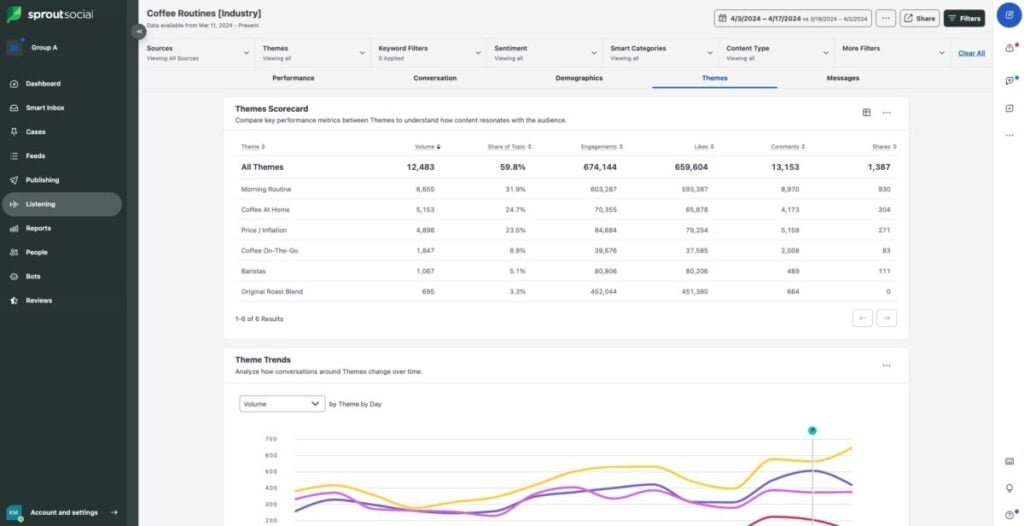
With your listening queries created, it’s a quick couple of clicks to get a look at the data. There, you can see the breakdown of the volume of mentions each keyword is getting, share of voice statistics, and various engagement metrics. A visual representation of these trends is depicted in a graph, and you can drill down into it to surface the content that caused the spike (or dip) in activity. And if you want someone on your team to see that content, you can tag them right there with a little message. This sort of collaboration isn’t restricted to just team members. Agencies who want to share reports and data with clients can easily do so, no extra license required. Just share a link and you’re all on the same page. This is the kind of workflow efficiency that Sprout Social aims for—and succeeds with—all over the platform.
Creating campaigns is equally well implemented and incredibly thorough. You’ll find the tools for this in the Publishing section, which is also where you’ll find your content calendar and queue, as well as all the approval and collaboration tools needed for content you want to schedule for publication. Any and all assets that pertain to a campaign—whether it’s content to be published, inspiration, or even analytics—can be attached to that campaign specifically, keeping your asset library from becoming too unwieldy. One of the cooler features here is the “Instagram Grid Planner,” which lets you see how uploading new images to your feed will affect the overall look of the grid.
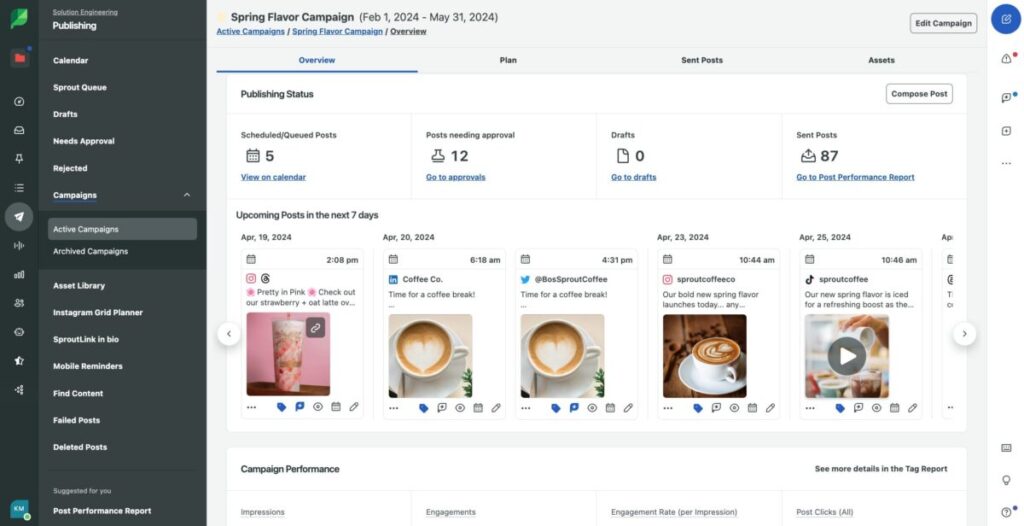
As organized as Sprout keeps you during the creation process, it’s when campaigns go live that its users will truly appreciate its flexible calendar. Multiple campaigns posting across multiple channels is an easy recipe for chaos, so Sprout makes smart use of filters to refine your view. Show only specific campaigns, or bring all content still waiting on approval to the fore. Whatever you’re looking for, the interface makes quick work of helping you surface it. Having found what you’re looking for, it’s again simple work to make changes or updates if you need to. You can simply click into the content itself and get to it. Another minor touch here that shows the level of thoughtfulness in Sprout: you can reference the campaign brief right in the same screen (instead of having to jump back to the campaign settings) to make sure everything meets requirements.
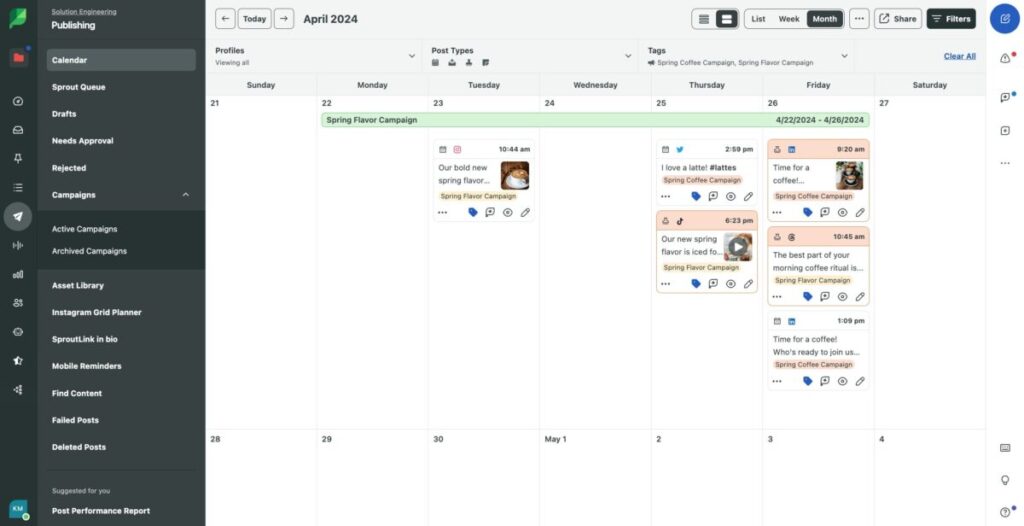
Possibly most important for any social media manager is a platform’s comms capabilities. The idea of a unified inbox on a platform like Sprout isn’t a new one, but here its use has been elevated to another level. It’s no secret that social media has become the front line for customer service—and the first place customers go when they’re frustrated. Sprout’s inbox uses AI to scan messages for sentiment, and can also flag those that really need your attention quickly. If all you could do was filter by these criteria, that would be pretty cool on its own. But the platform goes further, allowing you to set up custom rules and automations. Negative messages can be flagged and your team can be proactively notified of any message that requires immediate attention. These rules can be used to organize your incoming message in any number of ways, not just for crises.
As important as it is to respond to your audience, it’s just as important to look professional doing it. Toward this end, messages can be assigned to team members to make sure you’re not doubling up on responses—but even those that aren’t assigned are protected. The Sprout Social interface displays in real time whether someone is responding to a message, saving you from a comedy of errors and mixed signals. Add to this the platform’s integrations with Helpdesk and CRM solutions, and you can see how the smart inbox can become a crucial part of your marketing efforts.
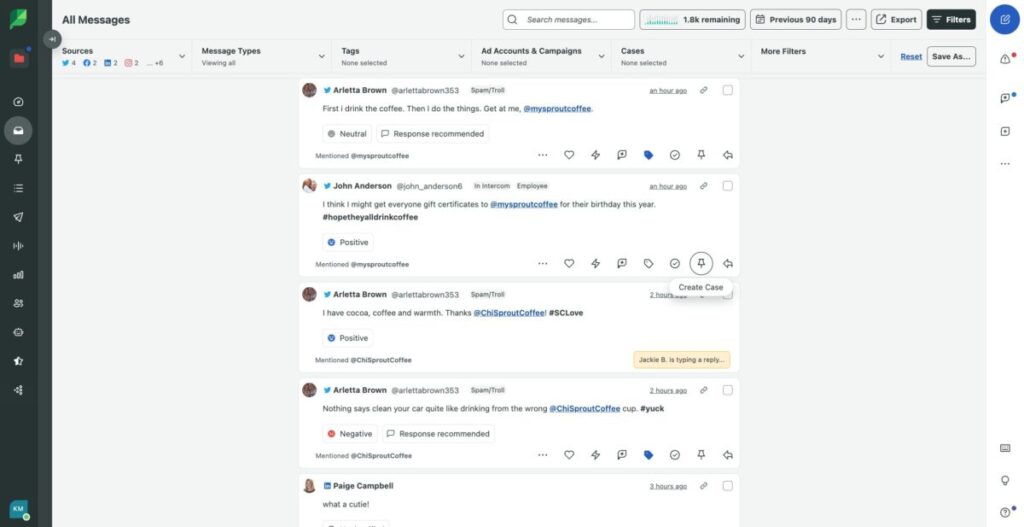
Finally, let’s move to reporting. Specifically, the ways in which Sprout’s reporting goes beyond just simple metrics and ROI calculations. One of the features of the platform is its ability to tag just about anything for organizational purposes. We touched on this with the inbox above, saying you can organize your incoming messages in any number of ways: the tagging feature is what we meant. You can automatically and manually tag just about anything in any way. You can tag campaigns, posts, audience comments, and content. This is some of the most holistic reporting on your campaigns that you can get.
Think about a single post tagged to a campaign. Then imagine that every like, share, and comment has the same tag as the campaign. And then think about every attribute you can tag onto those comments—the sentiment, was it a male or female, where in the world are they? Then think about the tags on the content itself: is it a video, or UGC, or a link? All these attributes become another data point in your campaign, and Sprout Social’s reporting puts them all into a context for you that’s invaluable. The flexibility of the reporting can’t be understated. Properly setup, Sprout Social becomes a kind of feedback loop where all the data you glean sets you up for the next campaign, where you’ll glean more data to be better prepared for the next campaign…
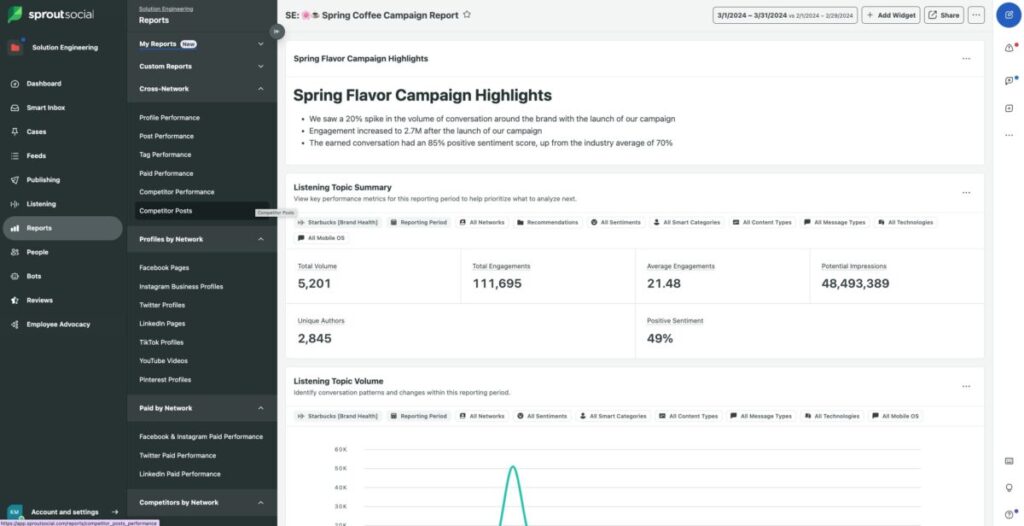
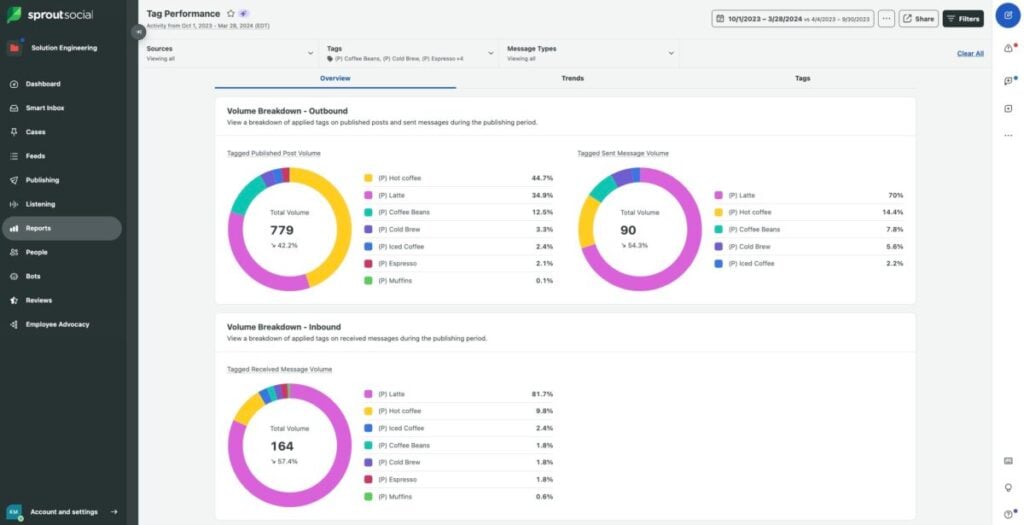
Conclusion
With nearly 15 years of history, a well recognized name, and no downturns or setbacks to report, it should come as no surprise that Sprout Social impressed us. We’ve seen hundreds of platforms over the years, so it’s become more rare that we see things we haven’t seen before. Sprout Social has grown and added functionality over the years, but it never strayed from what it does best. That core of features aimed at centralizing a social media manager's day onto a single platform is still here.
Added to that, though, are several new features that take a lot of the more tedious aspects of the job off its users hands. With improvements aimed at improving workflows, and not just the higher level work, Sprout Social shows us why it’s lasted so long. We don’t expect that to change anytime soon.
Frequently Asked Questions
How much does Sprout Social cost?
Sprout Social offers three plans:
- Standard - $249 per user per month
- Professional - $399 per user per month
- Advanced - $499 per user per month
Does Sprout Social have a free plan?
Sprout Social doesn’t provide a free plan. However, it does offer a free trial on the plan of your choice. You have 30 days to try Sprout Social, risk-free. No credit card is required to start a trial. After your 30-day free trial, Sprout Social asks you to pick a plan and enter your payment info. You can also request a free, customized demo and have a Sprout expert show you their social management suite, customer care, social data and intelligence, and advocacy solutions.
How does Sprout Social work?
Sprout Social is a professional social media management platform targeting the top end of the market. You begin by attaching all your social accounts. It places much emphasis on its Smart Inbox, which collects all your social messages. It also manages all your social tasks together – categorized as General, Leads, and Support. You can easily create content for all your social accounts, adding graphics, links, and other material as needed. Read the above review for more details on how Sprout Social works.
How do I post on Sprout Social?
If you want to start a post from scratch, you can create it in Sprout Social’s Create Post screen. If you enter a link, Sprout Social will find a recommended image for you to use. You can customize your post to meet the best practices of each social network. If you prefer a more graphical approach, upload images to an Asset Library. You can access content from many sources, which you can import and then reschedule and/or add to your queue.
Can Sprout Social post to Instagram?
Sprout Social integrates with Instagram and includes scheduling, publishing, engagement tools, and access to rich analytics. You can plan and schedule posts, monitor hashtags, and respond to comments with a comprehensive social management solution. Sprout accounts that connect their Instagram Business Profile(s) can directly publish a single photo or video from Sprout to Instagram on desktop, in much the same way you can publish to any other social network. You can also schedule posts and Instagram Story posts through the Sprout mobile app publishing workflow.
Can you schedule stories on Sprout Social?
You can post or schedule Instagram Stories using the Sprout Social mobile app publishing workflow. Use the workflow to compose your story post within Sprout’s desktop or mobile app. Then send that post to publish via your mobile device. A notification appears on Sprout’s mobile app at the appropriate time, prompting you to complete the publishing process. You can designate a user to act as your Instagram publisher so that they’re responsible for publishing the story post to Instagram.
Sprout Social – Social Media Management Software
-
Features
-
Ease of Use
-
Support
Sprout Social
Sprout Social is a heavy-duty social media platform targeting top-end companies, but also trying to keep itself relevant and affordable to small businesses. It is very user-friendly with a clear interface and excellent help documents. The unified social inbox is particularly impressive. Expensive if you work with a large team, but you may find its features outweigh the cost for your organization.
